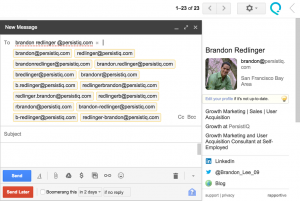You’ve spent the day putting out fires, extending deadlines, and scrambling from meeting to meeting. Untouched for days, your to-do list is gathering dust, and you feel totally unprepared for tomorrow’s quarterly sales review.
To some, that may sound like a nightmare; for you, it’s just another day at the office.
As a business leader, you’re used to controlled chaos. Your to-do list still needs to get done, but you understand which deadlines are flexible and which aren’t. You know when that crucial investor meeting takes precedence over previous commitments.
Good leaders renegotiate deadlines but don’t miss them. Good leaders drop everything to solve crises. Good leaders prioritize.
My 6 Pillars of Prioritization
In business, prioritization is everything. There’s always more to do than there is time to do it, and it’s easy to get mired in day-to-day drudgery.
To make the most of my days, I prioritize with these six tenets in mind:
1. Realize your job isn’t to bark orders.
If you think delegation means barking orders at entry-level employees, think again. When you delegate, make sure you’re playing to team members’ strengths, and always explain delegated responsibilities clearly. If you don’t understand the job to be done, then your employee almost certainly won’t.
Most importantly, when you delegate to others, grant them the authority to see that task through to completion. Micromanagement can be tempting, but workplace autonomy has been proven to improve productivity and satisfaction.
2. Tie each task to team goals.
Goals give employees direction and purpose, and they give you the peace of mind that your to-do list item will (eventually) get checked off.
But goals can’t exist just to keep workers busy. When I make my daily to-do list, I rank tasks according to their expected impact on the team’s goals. Some tasks, while nice to have done, don’t contribute to overall goals. You, as a leader, must spend your team’s time wisely, so delegate tasks that need to be done quickly but don’t fit on your calendar.
Try Basecamp for project management. My team uses this productivity software to ensure clients at certain brands know about priorities and progress.
3. Actually talk to your employees.
Have you ever gotten so caught up in your to-do list that, at the end of the day, you realize you’ve forgotten to share important updates with your team?
Trust me, it’s easy to do. But for your team to function as, well, a team, you need to keep everyone in the loop about organizational news. Priorities change constantly, and for employees to do their jobs well, they need to be aware of those changes.
Don’t forget to communicate up the ladder, either. If your supervisor doesn’t know that you’re stuck on a project, then he or she can’t provide you with additional time or resources. Summon the courage to renegotiate deadlines. Others depend on you, so they need to know if you’ll be late on a project.
4. Make time to help others grow.
When you’re juggling a million other responsibilities, it’s easy to forget that your job is to lead. But to help your employees grow, you need to set aside time for them.
I schedule biweekly one-on-one meetings with direct reports to discuss priorities and challenges and build rapport. I have an open-door policy with employees, but dedicating time to individual meetings reduces interruptions and keeps me accountable as a leader.
Whether you lead five employees or 500, spending quality time with employees builds loyalty, aligns individual priorities with organizational goals, and helps everyone overcome obstacles.
5. Seek fast, lasting solutions.
If you’re like me, you like to solve problems — not just in a “I put the fire out until next week” kind of way, but in a lasting, one-and-done manner.
Great leaders seek solutions that are both quick and permanent. If an employee isn’t getting his work done, the fastest solution might be to do it yourself. But that’s not a lasting solution. A true leader shows the employee how to do the work properly so the issue doesn’t crop up again tomorrow. If the employee simply doesn’t want to do his work, you shouldn’t wait to fire him — that is quick and permanent.
6. Have fun!
Being a leader is tough, no doubt about it. But if you can’t see the bright side of your job, you won’t want to get out of bed in the morning.
Did an employee close a major sale? Celebrate it! Take the team out to lunch, recognize birthdays, and let everyone be themselves at work. You’re leading people, not robots, so have some fun with it.
In business, change is the only constant. Sometimes, I get through a third of my to-do list, only to be blindsided by a pressing email or priority meeting.
As a leader, that’s life. Believe me, your to-do list will still be there tomorrow.
Business & Finance Articles on Business 2 Community(32)
Report Post






